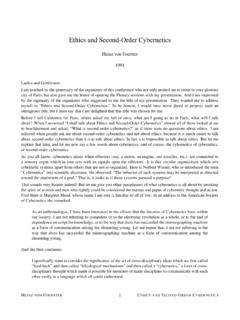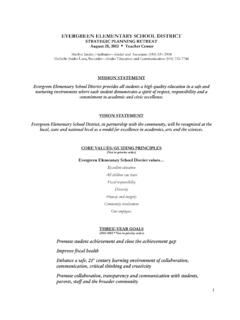Transcription of RELIGIOUS EDUCATOR’S - Evergreen Exhibitions
1 1 Over the centuries, the Catholic Church, specifically in the museums at the Vatican, has served as keeper of many objects of art. These objects are not kept for the wealth or the reputation of the Church itself. They are kept in the Vatican museums for the entire world to be educated, to be inspired by and to experience beauty, history and faith. This particular exhibition, which is visiting only two venues in the United States, provides many opportunities for Catholics to be enriched, to better understand their faith and to evangelize. The items in the exhibition do not stand alone; they present a broader picture of our faith and what has brought us to this period in time as the Catholics we are today. The lesson plans provided in this resource are for use in parish RELIGIOUS education programs and religion classes in Catholic schools. There is also a lesson for adults, which can be used in parish sessions, teacher in-services, small faith communities and numerous other settings.
2 The topics are not exhaustive, but hopefully will inspire visits to the exhibition to take on new and deeper meaning as a result of faith formation discussion. This exhibition is a wonderful opportunity for evangelization of many. Students can bring their families to a clearer understanding of the Catholic Church when they discuss what they have experienced during an exhibition visit. Adult Catholics can take friends from other faiths to the exhibition and then invite questions which can be discussed among them. Youth groups might set up activities with other parishes or other faith groups and engage in one of the lesson plans developed for their age group. Our faith is a gift from God and we are charged with going out to tell the Good News to all. The Vatican exhibition provides a fresh and exciting context for us to tell the Good News to others who might not otherwise be interested in our faith.
3 Portrait of a Cherub (1742), G. Zoboli Contents Vestments and Grades: 4 & 5 Faith Theme: Liturgical Items Saint Peter: Our First Grades: 4-8 Faith Theme: Church The Holy Grades: 6-8 Faith Theme: Church Inspired by Faith The Sistine Chapel Grades: 6 - 8 Faith Theme: Introduction to the Bible, Jesus, Church Selecting a Grades: 9-12 Faith Theme: Catholic Life & Belief Saints, Relics and Our Call to Grades: 9-12 Faith Theme: Church Doctrine, Church History Infallibility and the Grades: Adult Faith Themes: Church Doctrine, Ecclesiology These lesson plans have been prepared by members of the Office of Continuing Christian Education, Diocese of Galveston-Houston in Texas. (Updated March 2010.) RELIGIOUS EDUCATOR S GUIDE Contributions from: Anne Comeaux, Director Mark Ciesielski Charleen Iannucci Marianne Strzelecki Michael Way Margaret Altinger (non-staff contributor) Photo (top): Mosaic from the Oratory of John VII 8th Century Photos Citta del Vaticano Vatican Splendors A Journey through Faith and Art Vatican Splendors: A Journey through Faith and Art" is organized and circulated in conjunction with the Congregazione per l Evangelizzazione dei Popoli of the Vatican City State.
4 The exhibition is produced by Evergreen Exhibitions . Object photos Citt del Vaticano. 2 Catechist Background: The General Instruction of the Roman Missal and other resources give us answers as to why and how certain clothes or objects are used during liturgical celebrations and services. One reason is that they enhance the beauty and solemnity of the service. Approximately 1300 years ago, ministers started wearing certain vestments (a word meaning clothes) during Mass and other RELIGIOUS ceremonies. By the 9th century, Church leaders had decided on specific vestments that would be worn by each minister at Mass. Many of these garments are designs based on those used during the early Christian centuries. They still symbolize the diversity of ministries present and their specific functions during various liturgical services. Saint Paul writes in 2 Timothy 2:20-21, there are vessels of gold and silver but also of wood and clay, some for distinguished and others for common use.
5 Just as every home has a variety of dishes, with certain ones to be used for special occasions, the Church too makes use of certain special vessels for its celebrations of Christ Items such as the chalice, paten and ciborium are referred to as sacred vessels and hold a place of honor because they are used in direct contact with the Blessed Sacrament. The vessels used in worship symbolize the role of the Christian, shared by all members, making the Church a chosen vessel of God. Chalice of Saint John Paul II 2001 Gilt silver, vitreous gems Private Collections, Vatican City State PART ONE Grades 4 & 5 Learner Objectives: The learner will 1. Gain knowledge of correct terminology for various liturgical items and sacred vessels. 2. Gain additional knowledge regarding the history or usage of various items. 3. Have a hands-on opportunity to view vestments and vessels being studied.
6 4. Be challenged to expand their knowledge of additional liturgical items terminology and usage. Materials: Various liturgical items; alb, stole, chasuble, paten, chalice, ciborium, sacramentary, lectionary or other items available from your church sacristy. The Liturgy Documents, A Parish Resource, LTP Publishing. The Catholic Source Book, Brown-Roa Publishing. Why Do Brown-Roa Publishing. Other resources that contain definitions and explanations of liturgical items. Vestments and Vessels Faith Theme: Liturgical Items Above: Chasuble of Cardinal Borghese (1734-1782) White lamina and gold embroidery Basilica of Saint Mary Major 3 Place liturgical items in various locations around the classroom, or if possible, a larger meeting room. Begin lesson plan by asking students to discuss occupations that they know of where uniforms and certain items are used specifically for that profession/vocation.
7 Some students may have parents or relatives in such positions, or know someone in the military. Allow students to share with the entire class what they know about such specifics of various positions. Use this discussion as the bridge to explain some background information and history regarding liturgical vestments and vessels. Using resources listed above, or others available in your parish, have students work together in small groups of 3-5 persons, researching the correct terms and definitions for the various items at each location. Have multiple copies of information from various resources available to aid each small group of students in their work. Each student will create their own paper with the names of definitions of each item written down. When each small group has successfully completed gathering the correct information for every item, they should continue to work together to write a brief (1-2 page) creative story using ALL of the terms that they have just learned.
8 Each group will have an opportunity to teach the class about these items by reading their finished written assignment. Bonus: by using provided resources, each group will attempt to incorporate any one additional item and its meaning into their creative story assignment. Prior to touring the Vatican exhibit provide students with a list of items to look for among those displayed within the exhibition that they will be learning about in this lesson. Extra credit could be earned by taking notes of various details of items and sharing that information with the class in a follow up lesson. The list could include the following: the chasuble of Cardinal Scipione Borghese cope of Saint Charles Borromeo (1538-1584) the chalice and paten of Pope Pius IX the ciborium of Saint John Paul II, and Roman Missal with Silver Binding. Alternative Suggestions: Have similar items displayed in your parish sacristy and altar area and take your class on a tour of your own church while they do the same activities.
9 Challenge students to locate as many additional items as they can to identify on their individual papers. Have a priest or deacon visit the class to display and explain some of the vestments and vessels seen and used during Mass. Other Suggested Activities: Contact the sacristan at the Cathedral or Co-Cathedral in your diocese and schedule a guided class tour to view many items used by the Bishop that are not available in your own parish. View portions of the videos Come On In! Part 1 & 2 (Twenty-Third Publications), and discuss what they saw and heard that they did not know before. Allow students to create a stole with fabric remnants and fabric paints or design one on paper with colored markers or fabric scraps or create a chalice using clay or other available materials. VESTMENTS AND VESSELS Catechetical Lesson Plan and Activity Assessment: 1. Create Jeopardy, Wheel of Fortune or Pictionary type games using items and definitions listed above that the class can play in small or large groups.
10 2. Students will write a story utilizing all of the liturgical terms learned. 3. Students will match a drawing or a picture of a liturgical item to the correct liturgical name. 4. When shown a photo, or the actual item, students will be able to correctly write or state the name of the item. 4 Alb: (means white) the full length loose fitting white tunic, symbolic of the garment worn by someone newly baptized, indicating a sign of the purity of heart the priest, bishop or server seeks in preparing for the Mass. Stole: the long, narrow strip of cloth, the same color as the chasuble. It drapes over the shoulders, reminding the wearer that Christ s yoke is easy and his burden is light (Mt. 11:29-30). It is a sign of priestly office and is worn by priests and deacons. The priest drapes it around his neck and allows it to hang loose in front. The deacon drapes it over his shoulder, crosses it to the side and fastens it. Chasuble: the outer, poncho-like garment, the color of the liturgical season or celebration, worn by the celebrant of the Mass.





